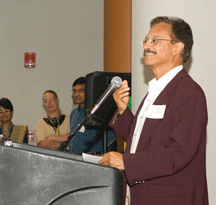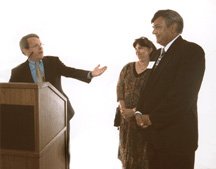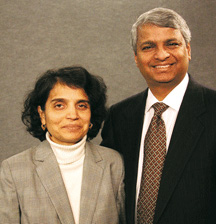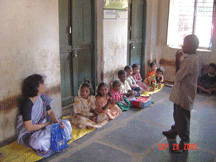Magazine
The Heart Of Giving

Indian Americans are opening up their checkbooks for philanthropy...
|
What can you do with $20 million? Park it in a bank, buy a mansion – or simply give it all away! Rajendra B. Vattikuti, President and CEO of Covansys, and his wife Padma Vattikuti of Farmington Hills, Mich., donated $40 million toward cancer research, one of the single largest such gifts in the history of Michigan: $20 million to Henry Ford Hospital to support prostrate cancer research and $20 million to Beaumont Hospital for breast cancer studies. Krishan Joshi, founder and chairman of UES, Inc, a high-technology research company in Dayton, Ohio established the $10 million Krishan and Vicky Joshi Research Center last year at The Wright State University College of Engineering and Computer Science. Desh Deshpande, co-founder and chairman of Sycamore Networks in Boston, Mass., and his wife Jaishree Deshpande established The Deshpande Center at the MIT School of Engineering with a $20 million gift. These are just a few of the several examples of Indian Americans entrepreneurs catapulting themselves into philanthropy on a big scale.
Deshpande’s objective behind MIT’s Deshpande Center was nothing short of getting the “economy in the US going.” Since 2002, the center has funded 64 projects with over $7 million in grants. Eleven projects have spun out of the center into commercial ventures, collectively raising over $88 million in outside financing from 12 venture capital firms. “What happens in a global economy is that if a job can be done in India or China it will not stay in the U.S. So the only way you can maintain the standard of living and keep the economy going is by innovation and that innovation will happen in technology. So the idea behind The Deshpande Center is to truly find a new model to turbo charge the innovation economy,” says Deshpande. The problem, he says, is that innovative research in universities often occurs in a vacuum without access to real world experiences: “What the Deshpande Center has done at MIT is to connect these professors and innovators to entrepreneurs and venture capitalists in a very methodical program. As a result the chances of having an impact have gone up tremendously.” It should come as no surprise that Indian Americans, who have the highest educational attainment of any group in the United States, are partial to higher education in their philanthropy.
One of the earliest such initiatives in the community established an India Chair at Columbia University. Since then, Indian Americans have endowed several chairs at U.S. universities. Narpat Bhandari, a private venture capitalist and co-founder of The Indus Entrepreneurs (TIE) in Santa Clara in Calif., endowed the Chandra Bhandari Chair in India Studies at the University of California, Santa Cruz, in 1997. At the University of California, Berkeley, the Center for South Asia Studies has several endowed chairs, including the Sara Kailath Chair in India Studies, established by Thomas Kailath, and Vinita and Narendra Gupta in honor of Kailath’s wife Sara, as well as a Chair in Tamil Studies. At the University of California, Los Angeles, Dr. Mohindar Brar Sambhi endowed a chair in Indian music in memory of his late wife, and Navin and Pratima Doshi established a chair in Pre-Modern Indian history. In 1999, Dr. Narinder Singh Kapany, chairman of the Sikh Foundation pledged $500,000 and some 100 Sikh art objects to the Asian Art Museum in San Francisco to establish the Satinder Kaur Kapany Gallery at the Museum. Vinod Gupta, founder and CEO of infoUSA, has poured $20 million in founding educational programs in India. He established the Vinod Gupta School of Management and the Rajiv Gandhi School of Intellectual Property Law at his own alma mater, the Indian Institute of Technology in Kharagpur. Seven years ago he turned to his birthplace, Rampur, to found the Shrimati Ram Rati Gupta Women’s College, which trains over 900 women every year in professions like computers and education. He also set up the William Jefferson Clinton Science and Technology Center in Rampur, and most recently the Hillary Rodham Clinton Mass Communication Center for Journalism and Media Management. “My philosophy is that, after I die, everything will go to charity,” Gupta says.
$20 million is the amount that Raj Soin, chairman of MTC Technologies, in Dayton, Ohio, donated to establish a business school at Wright State University. Soin, who is president and founding trustee of the Ohio-India Project, says it is vital for Indian Americans to direct their philanthropic efforts at both India and America. Local initiatives of the Ohio-India Project include the Gandhi House, which provides transitional housing to battered women and their children, and the Annual Day of Caring, which started in Dayton, and is now held in several states, on the third Sunday in February during which volunteers cook for charity, and doctors and lawyers donate their services. Says Soin, “It has not gone national, but it’s starting to catch up.” In 1990 Soin donated 180 acres of prime land in Beavercreek, Ohio, to build a public golf course. He says, “We spend a lot of our life in Beavercreek and what we found was there were two golf courses in this town and both were private, to which ordinary citizens had no access. We donated the land to the town so the public could have access to a golf course. This is the town where both my children have been brought up and where we’ve spent 25 years.” Did he struggle in determining the focus of his philanthropy? Says Soin, “In reality I tell people charity begins at home and we as Indians have to learn that this is our adopted home, so first thing we should do is take care of things locally, then we reach back to India. We as Indians, if we’ve adopted this land and we don’t really go all the way, as locals do, we will always be outsiders. “I always remind people of East Africa. If you don’t want to become part of a society, our children in future will suffer. This is where your grandchildren are going to be growing up. Rather than talking about divided loyalties, I say have your loyalty first where you are and then reach back and go to your roots.”
Soin’s philanthropic interests are in education and health care: “Firstly, I believe education is one of the best gifts you can give anybody because that gives a person ability to benefit for the lifetime. Secondly, as long as a person has good health, they can have the ability to earn for themselves and will not have need for additional philanthropic support.” He says, “With the business school and Wright State University I was very heavily involved for years on the advisory boards and the board of trustees and felt it to be a very good cause to enhance the business education in this area. Most of my businesses are headquartered in this area.” This year Soin established the non-profit 55-bed Sukh Dev Raj Soin Hospital in rural Haryana and he also supports the Soin Scholar Program, which funds the MBA education at Wright State University for three graduates every year from Delhi College of Engineering, his alma mater. Soin says while Indian Americans are beginning to become more active in philanthropy, they lag the mainstream. “I don’t think I see the same thrust as in the local community, but it is increasing and getting better. When I started the Gandhi project years ago, in spite of there being such a large Indian community, more than 80 percent of the money that I raised was from non-Indians. Initially Indians were focusing just on giving to the building of temples.”
But things are beginning to change. He points to the example of Monte Ahuja, an entrepreneur in Cleveland, Ohio, a major benefactor of Cleveland State University, who recently donated $30 million to establish the Ahuja Medical Center. Then there are the philanthropist physicians, Drs. Kiran and Pallavi Patel of Tampa Bay, Fl., who established the Patel Foundation for Global Understanding in 2003, through which they have built schools and hospitals on three continents – India, Africa and the United States. Born in Zambia, Patel has retained his links to that homeland too. Both doctors had thriving medical practices and in 1988 Patel took over a struggling HMO, Wellcare, and transformed it into the largest Medicaid HMO in Florida. By the time Dr. Patel sold the majority of his interest in Wellcare in 2002, the company had annual revenues of over $1 billion. Both Patel and his wife Pallavi have contributed generously to several philanthropic projects in Tampa. Establishing a performing arts conservatory, a research center at Pepin Heart Hospital, and a center for global solutions as well as a charter school and pediatric center at University of South Florida. In India they have set up a rural village restoration project and helped in earthquake relief in Gujarat, while in Zambia they have set up the C.A. Patel Hospice Center in Lusaka, Zambia and a heart hospital in Dar-e-Salaam, Tanzania.
Entrepreneurs turned philanthropists, not surprisingly, bring entrepreneurial angles to their giving. Says Deshpande: “As an entrepreneur you learn that what you want to do is to create impact and you need to create impact everywhere in the world. So the idea is to take problems and connect them with good minds, to try and bring innovation to help the lives of marginalized people.” He has tried to replicate the Silicon Valley model in social entrepreneurship in India, creating a community where social entrepreneurs can exchange ideas and find funding to back them. “So you have change agents, you have some financial resources and you’re creating some buzz. What happens in the business world is you may sell a pen for a dollar, but you spend $100,000 developing the technology and then you duplicate it. Whereas in social entrepreneurship, people start with a good heart but they are totally under-resourced in terms of engineering, management and finance.
“What we are trying to do here in this social entrepreneurship sandbox is to really fine-tune these ideas to the point where it is fully developed and then you can duplicate it in other parts of India and in other parts of the world. So it’s really like a development lab.” Deshpande’s “sandbox” is located in the Hubli area, north of Karnataka. The Deshpande Foundation funds over 50 NGOs in India in the areas of agriculture, microfinance, livelihood, education and health. He says his foundation takes a venture philanthropy approach with Akshaya Patra, which is a school lunch program based that feeds over 800,000 children daily in India. The foundation funded the setting up of the facilities and has also started a U.S. fundraising operation, which raised over $100,000 for it. Corporate heads and Indian professionals are playing a leading role in taking many Indian nonprofits to the next level. A Little India examination of the returns of several Indian non profits found that in 2005 several crossed the $1 million dollar fundraising mark: Share & Care with $3.76 million; Asha for Education $3.11 million; Pratham $2.16 million; Sankara Eye Foundation $1.37 million.
The leader by far is the America India Foundation (AIF), whose honorary chair is President Bill Clinton, which raised $7.8 million in 2005 and a total of $40 million since its inception in 2001. Its initiatives center on education, livelihood, and public health projects in India. The list of AIF trustees and donors reads like a who’s who of business moguls: Victor Menezes, former Senior Vice Chairman, Citigroup; Rajat K. Gupta, Senior Partner Worldwide, McKinsey & Co; Tushar Dave, Co-Founder and Managing Director, New Path Ventures; Vinod Dham, Co-Founder and Managing Director, New Path Ventures; Peter Hero, Senior Advisor, Silicon Valley Community Foundation, Ravi Reddy, Co-Founder and Managing Partner, Think Capital, Chandrika Tandon, Chairperson, Tandon Capital Associates. Pratham, which was started in the slums of Mumbai in 1994 to universalize primary education has been tapping Indian American professionals for financial support. Vijay Goradia, a Texas entrepreneur, was responsible for getting Pratham off the ground in the U.S., challenging and matching the donations from the Houston community. During the past few years Pratham USA has created a national presence, attracting donors to its fundraisers, featuring the noted actress Waheeda Rehman as its ambassador.
Mahalingham Ramesh, of Raleigh, N.C. current president of Pratham USA, says the organization has adopted many mainstream fundraising tools. “What you’re seeing is almost the evolution of the cultural assimilation. When Indians see a culture where giving is much more common, they also follow up on that. Also the baby boomers that came here 30 years ago and made it big here, they are now at that stage in their life where they do want to give back. Many of them give money and many of them are also willing to go and spend some time in India.” Share and Care, based in New Jersey, has raised $15 million and another $25 million in kind, including medicines and surgical equipment, in the 23 years of its existence. It is registered with USAID and United Way, allowing donors to designate it as their charity of choice in United Way campaigns. The Sankara Eye Foundation, based in California, supports the work of Sankara Eye Society (SES), which operates one of the largest rural outreach eye-care programs in India through its three eye hospitals in Coimbatore, Krishnan Kovil and Guntur. With support from Mission for Visions, Sight Savers and Infosys, SEF is currently developing its newest hospital in Bangalore, which will provide 25,000 free surgeries every year.
Murali Krishnamurthy, one of the co-founders of the Sankara Eye Foundation, says: “We made the organization look at the very big picture. We took them to a new level, like Americans think really big. Guntur Hospital was constructed at a cost of $1.5 million and it is completely our baby and the Telegu Association of North America played a big role in it. One of the doctors, Dr. Korali, donated $1 million.” A U.S. volunteer suggested the catch-phrase for what has now become the mission for SES: “Vision 20/20 by the year 2020” by performing a million free surgeries for the curable blind in India. Last year SEF raised $2.5 million and hopes to cross $3 million this year. Krishnamurthy says the organization has consciously adopted mainstream fundraising techniques: “Basically we’re all volunteers, with just two paid office workers and rented space in Milpitas; the volunteers attend to fundraising, marketing and donor relations. I’ve seen Americans organize events – how meticulously just a few people work in the background so it looks like a well-oiled machine.” As he is a customer relations manager in his day job and also practices music, he says, starting on time and paying attention to details are some of the American values he’s imbibed and put into practice in Sankara Eye Foundation fundraising events. “People tell me that ‘Attending a Sankara event is like attending a marriage on the bridegroom side!'” The foundation stays in regular communication with donors, conducts ad campaigns and has an 800 number to call in donations. Over 20,000 Indian American donors from all parts of India have supported SEF. He says, “We’ve done all these things to make the life of donors easy. We do big scale events. During Navratri, SEF organized a dandia celebration in the Bay area for 8,000 people. We go into these communities and make them own the hospitals.”
American Kannada Koota Association was a partner in the hospital venture, raising $100,000 for the project. For the Andhra Hospital, the Telegu Association of North America and the Bay Area Telegu Association each raised $100,000. For a hospital in Gujarat, SEF is working with the Asian Hotel Owners Association and the Potidar Samaj. Says Krishnamurthy, “That’s one of the formulas that is really working well for us. We know that if you don’t leverage the community, you cannot be successful.” Asha for Education, which was established by second generation Indian Americans, likewise has proved exceedingly successful in tapping the community for funds for education in India through a network of volunteers. Asha has 66 chapters worldwide: 45 in the US, 14 in India and 7 in Europe, Singapore and Australia. The organization has more than 1,000 active volunteers and several thousand supporters around the world and has disbursed $4 million on 385 projects in 24 states in India since its inception. Even relatively small local organizations have seen the value of leveraging mainstream fundraising techniques for valuable causes. Children’s Hope India, which was started several years ago with $200 in seed money donated by each of its women founders, has used big name fashion designers, authors and artists to draw audiences to its lavish fundraising galas. This year Pulitzer Prize winner Jhumpa Lahiri, accompanied by such celebrities as Sarita Choudhury, Rachel Roy, Damon Dash and Anupama Chopra, helped raise $500,000 at its annual event, which attracted both individual and corporate support from Indians as well as the mainstream. Innovative collaborations abound. Pratham’s Read India movement, an accelerated learning program to help 60 million children in 100 districts in 10 states to read, write and learn basic arithmetic, has secured a $9 million grant from a partnership between the William and Flora Hewlett Foundation and the Bill and Melinda Gates Foundation to improve the quality of education in developing countries. Ingrid Srinath, CEO of CRY and trustee of CRY America, explains how the organization has tapped working professionals segment to support their services. “We have a large and very committed volunteer base with 300 volunteers in 20 cities and in addition to their day jobs they regularly mount events through which they raise money for CRY,” says Srinath. “These event range from something as simple as college students washing cars for CRY to a raffle in Atlanta – every medium they can access.” In Seattle, CRY America organizes a major gala, which is attended by professionals from companies like Boeing, Amazon and Microsoft. She says, “People have worked in those companies and in the period of one evening they raised about $180,000 through that dinner.” How responsive are Indian Americans to their appeals? Srinath says: “Most Indians feel they need to give back to India. Children and education are two of their favorite causes, partly most of them are where they are because of the education they got. Most people do want to make a difference and as long as we non-profits can make it convenient and if you can convince them that their money is being used effectively, people will give you money.” Almost 90 percent of the money CRY raises comes from sale of greeting cards for as little as $2 and admission to its low priced events. She says, “I call it a retail model of fundraising rather than a wholesale model, where you go to a few large donors. The idea is to make it as accessible as possible to the largest number of people.
“One of the things we know is we are not going to solve the kind of problems India’s children are facing, 60 million children out of school, you’re not going to solve that by private philanthropy alone. You’re going to have to change attitudes and in order to change attitudes you need to reach out to a lot of people. It’s not enough to pass laws. It has to come to that the middle class really sees child labor as intolerable.” She says the average donation size to CRY is $150. CRY has adopted many mainstream fundraising techniques, Srinath says: “America is the market that originated the idea of stand up comedy, so we’ve had events like ‘Laugh for CRY.’ For the first time we had people playing poker for CRY and also the sponsored walks originated here and is something which continues to happen almost entirely here. That’s a popular way of raising money here, but is just beginning to happen in India and other markets.” The encounter with America and the entrepreneurial success of Indian Americans is transforming the Indian philanthropic landscape. Says Deshpande; “When we were young, at home if you fed one kid and helped him go to school that was a big thing, because that was the scale we could think of, with the resources we had. But now we do have more resources so we can solve problems in a bigger way. “You have to come up with programs that impact a million, ten million, a hundred million people. In India you have people with very good hearts. India is the only place with one million NGOs, but each NGO is somewhat dysfunctional, because they all start with a good heart and limited funds and too many problems to solve. So it doesn’t fully leverage, it’s like an unorganized market.” The entrepreneur in him sees the opportunity. “It’s very rare that in the same community, in the same country, you actually get both these two things happening. On one side you have huge problems – 500 million people who can’t read or write and other big problems. At the same time you have a lot of people who have a very good global perspective, because they sit there and solve the problems in London and New York and all over the place. “India has really figured out how to scale things and solve problems for everyone else in the world. The opportunity that I see for entrepreneurs and philanthropists is to work with government to really bring those two things together, because only then can you have an impact. Then I think it will be a great example of what public and private partnership can do.”
|












